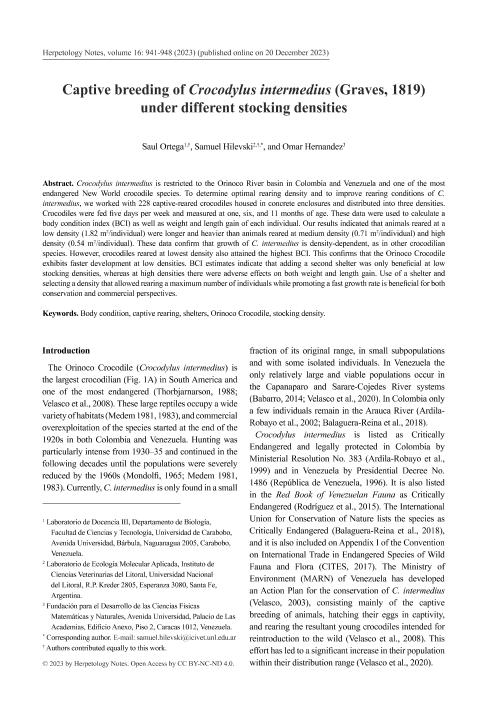Mostrar el registro sencillo del ítem
dc.contributor.author
Ortega, Saul
dc.contributor.author
Hilevski Loreto, Samuel

dc.contributor.author
Hernandez, Omar
dc.date.available
2024-02-06T13:37:06Z
dc.date.issued
2023-12
dc.identifier.citation
Ortega, Saul; Hilevski Loreto, Samuel; Hernandez, Omar; Captive breeding of Crocodylus intermedius (Graves, 1819) under different stocking densities; Societas Europaea Herpetologica; Herpetology Notes; 16; 12-2023; 941-948
dc.identifier.issn
2071-5773
dc.identifier.uri
http://hdl.handle.net/11336/225947
dc.description.abstract
Crocodylus intermedius is restricted to the Orinoco River basins in Colombia and Venezuela. It is also one of the most endangered New World crocodilians. To determine the optimal density of individuals and the number of refuges to improve the rearing conditions of C. intermedius this study used 228 captive-reared crocodiles that were split in three individual densities and housed in concrete tanks. They were fed five days per week and measured at one, six, and eleven months of age. These data were used to calculate body condition index (BCI), weight, and length gain of each individual. Our results indicated that animals of groups group B (1.82 m2/individuals) were longer than animals of groups A (0.71 m2/individuals) and C (0.54 m2/individuals). While animals of groups A and C were less heavy than animals of group B, indicating that the density of C. intermedius is inversely correlated with their growth like in other crocodilian species. Whit respect to the BCI, group B had greater BCI than group A and C. This confirms the Orinoco crocodiles have a better development at relatively low densities. Through to the BCI we can be conclude that adding a second refuge only beneficial at “low” densities (associated with higher food conversion rates), whereas at “high” densities adverse effects on weight and length gain. To C. intermedius use of a second refuge and select a density that let rearing a major number of individuals and promoting a fast growth rate is beneficial for both conservation and commercial perspectives.
dc.format
application/pdf
dc.language.iso
eng
dc.publisher
Societas Europaea Herpetologica
dc.rights
info:eu-repo/semantics/openAccess
dc.rights.uri
https://creativecommons.org/licenses/by-nc/2.5/ar/
dc.subject
Body condition
dc.subject
Captive rearing
dc.subject
Shelters
dc.subject
Orinoco Crocodile
dc.subject
Stocking density
dc.subject.classification
Ecología

dc.subject.classification
Ciencias Biológicas

dc.subject.classification
CIENCIAS NATURALES Y EXACTAS

dc.title
Captive breeding of Crocodylus intermedius (Graves, 1819) under different stocking densities
dc.type
info:eu-repo/semantics/article
dc.type
info:ar-repo/semantics/artículo
dc.type
info:eu-repo/semantics/publishedVersion
dc.date.updated
2024-02-05T13:40:51Z
dc.journal.volume
16
dc.journal.pagination
941-948
dc.journal.pais
Alemania

dc.description.fil
Fil: Ortega, Saul. Universidad de Carabobo.; Venezuela
dc.description.fil
Fil: Hilevski Loreto, Samuel. Consejo Nacional de Investigaciones Científicas y Técnicas. Centro Científico Tecnológico Conicet - Santa Fe. Instituto de Ciencias Veterinarias del Litoral. Universidad Nacional del Litoral. Facultad de Ciencias Veterinarias. Instituto de Ciencias Veterinarias del Litoral; Argentina
dc.description.fil
Fil: Hernandez, Omar. Fundación para el Desarrollo de las Ciencias Físicas Matemáticas y Naturales; Venezuela
dc.journal.title
Herpetology Notes
dc.relation.alternativeid
info:eu-repo/semantics/altIdentifier/url/https://www.biotaxa.org/hn/article/view/71885
Archivos asociados
